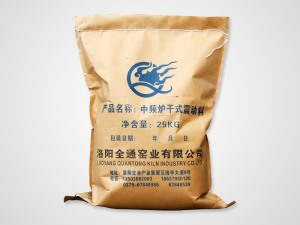What are the types of intermediate frequency furnace lining materials?
The quality of the intermediate frequency furnace lining determines the service life, and it needs to have excellent refractory performance and stability to be put into use better. The intermediate frequency furnace lining of different materials will react differently with the raw materials during use, so what material is selected depends on Use it to judge, let me tell you what material is used for the lining of the intermediate frequency furnace.
1, acid lining
Acid furnace lining is mainly quartz sand, which is cheap, widely distributed, good in insulation, low in construction requirements, less in use, and relatively stable in production. There are two phase changes during the heating process, the dimensional stability is poor, the chemical stability is not ideal, and it is easy to react with the slag to form corrosion, which is the main reason for affecting the service life of the intermediate frequency furnace lining. In order to prevent these shortcomings, fused silica can be used. 2 When the content of silicon oxide is greater than 99%, the refractoriness is obviously improved, close to the melting point, and there is no two phase transitions when heating, there is no heating scale change, and the thermal shock stability is also greatly improved.
2, Neutral furnace lining
Using fused corundum as the lining of the intermediate frequency furnace, because the melting point of white corundum is as high as 2050 degrees Celsius, the hardness is as high as 8, the wear resistance, high temperature resistance, and chemical stability are better than quartz. It is suitable for high temperature cast steel or large furnace lining. The characteristics are the same as Due to the disadvantages of large phase transformation and thermal expansion coefficient, the addition of spinel powder in practice can significantly improve corrosion resistance and dimensional stability.
3, basic furnace lining
The traditional basic furnace lining is formed by dry ramming of magnesia, which has the advantage of high refractoriness, close to 2800 degrees Celsius, but the disadvantage is that the expansion coefficient is large, easy to crack, the magnesia lining is corrosion-resistant, long service life, low price, and widely used. Adding white corundum powder or spinel powder can significantly improve the service life.
4, Spinel lining
Spinel lining is a new type of furnace lining material. It is formed by alumina and magnesia, pre-formed by high temperature sintering or electric melting, and then produced in various particle sizes as required. Using borax or boric acid, it has the advantages of white corundum lining and magnesia lining, and avoids its shortcomings. It is the development direction of large-scale intermediate frequency lining and high-temperature lining. Many imported lining materials belong to this type.
5, New material furnace lining
Adding ultrafine powder (mostly in a few microns) in traditional furnace lining materials can improve the corrosion resistance and thermal shock stability of furnace lining materials, such as silicon powder, alumina powder, white corundum powder, spinel powder, etc.

Related News
- Introduction of construction method of ramming material in intermediate frequency furnace
- How to choose the material of furnace lining
- The difference between rammer and castable
- Application direction of intermediate frequency furnace refining
- Introduction to the construction method of dry ramming material
- Do you know the production process and control points of breathable bricks?
- The application of argon blowing technology at the bottom of the intermediate frequency furnace
- Method for prolonging service life of intermediate frequency furnace lining
- In addition to diffused breathable bricks, there are those types of breathable bricks
- What are the advantages of coil cement
- What is the effect of the ingredients of the intermediate frequency furnace lining material on the application?
- What are the aspects of reducing energy consumption of breathable bricks?
- What are the requirements for manufacturing materials of breathable bricks?
- What are the material requirements for the production process of breathable bricks?
- What material is used for the lining of the intermediate frequency furnace? What are the common types?
- How to choose the type of intermediate frequency furnace ramming material?
- What are the key points for the selection of intermediate frequency furnace lining materials?
- What are the effects of melting temperature on the composition of intermediate frequency furnace lining materials?
- The intermediate frequency furnace ramming material itself protects the furnace and the coil
- About the sintering problem of intermediate frequency furnace lining materials


